The Cost of Commitment
Posted on April 30, 2018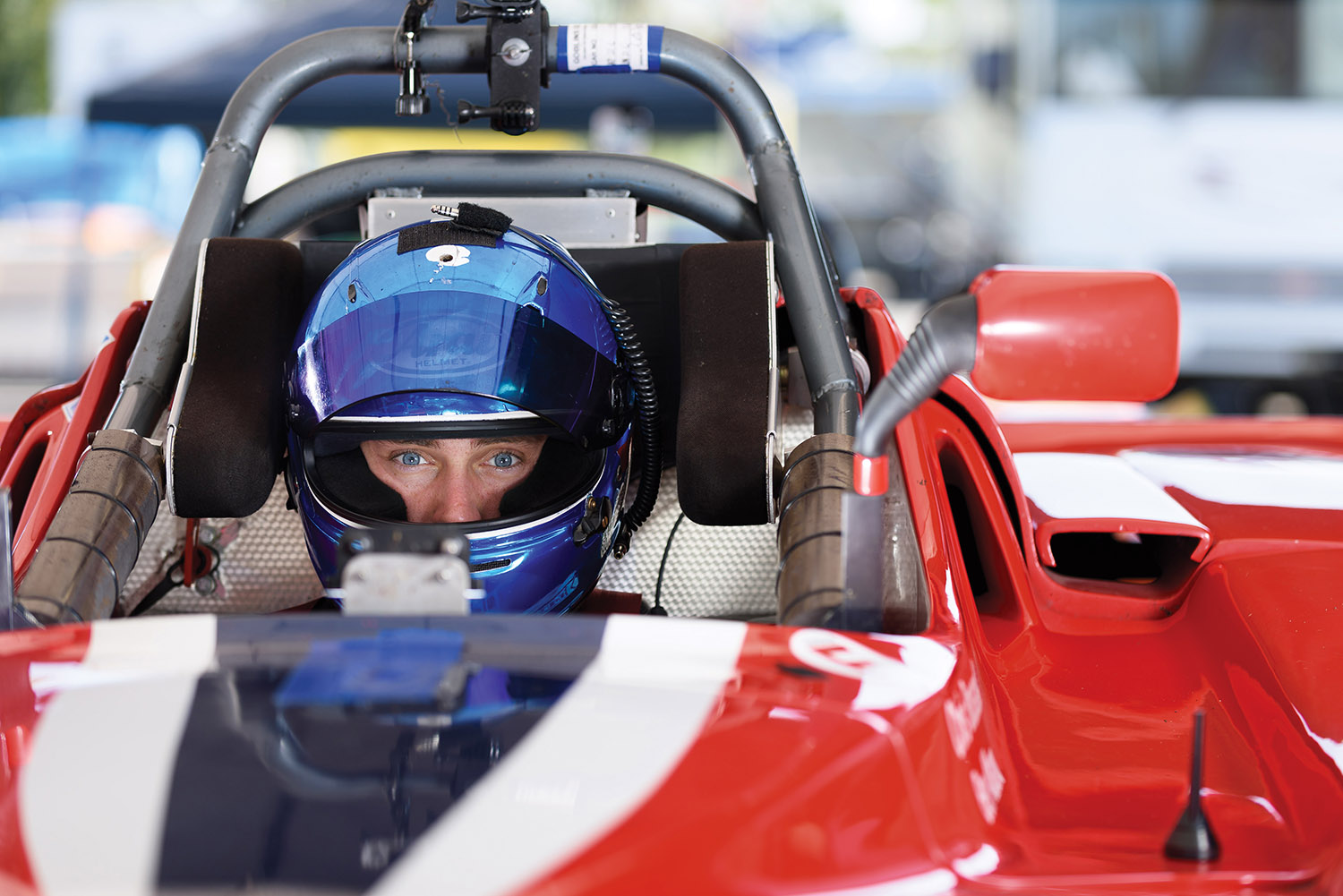
Here’s looking at you, from behind the wheel, from behind the mouthpiece. Having competed on race tracks for 10 years, and succeeded at every level, Ben Albano came to Carolina as a music major. (Photo by John Joyner)
When Ben Albano ’18 arrived in Chapel Hill, he already knew glamour and danger, exhilaration and heartbreak. He was a recognized talent in a field of limited opportunities. Taking time out for college was a risk he did not consider optional.
by David E. Brown ’75
Eight of us pile into the Escalade and pull out of the busy garage at Virginia International Raceway. A bridge takes us over the frantic rush and the high-pitched whine on the track below. On up the road is the relatively placid south corner, where we find a small wooden grandstand and a splendid vantage all to ourselves.
Placid for the civilians — the drivers have their hands full with the second-tightest of the 18 turns. This is where Ben Albano ’18 first drove in a race, where he began the long process of understanding that 25 percent of a successful driver’s job is controlling an organized heap of complicated machinery and that the other three-fourths is the hard part: negotiating, selling, pleading, listening, watching.
At this moment, it’s studying the technique of his teammate and mentor, who’s handling the second half of an endurance race. Albano had run the first half admirably.
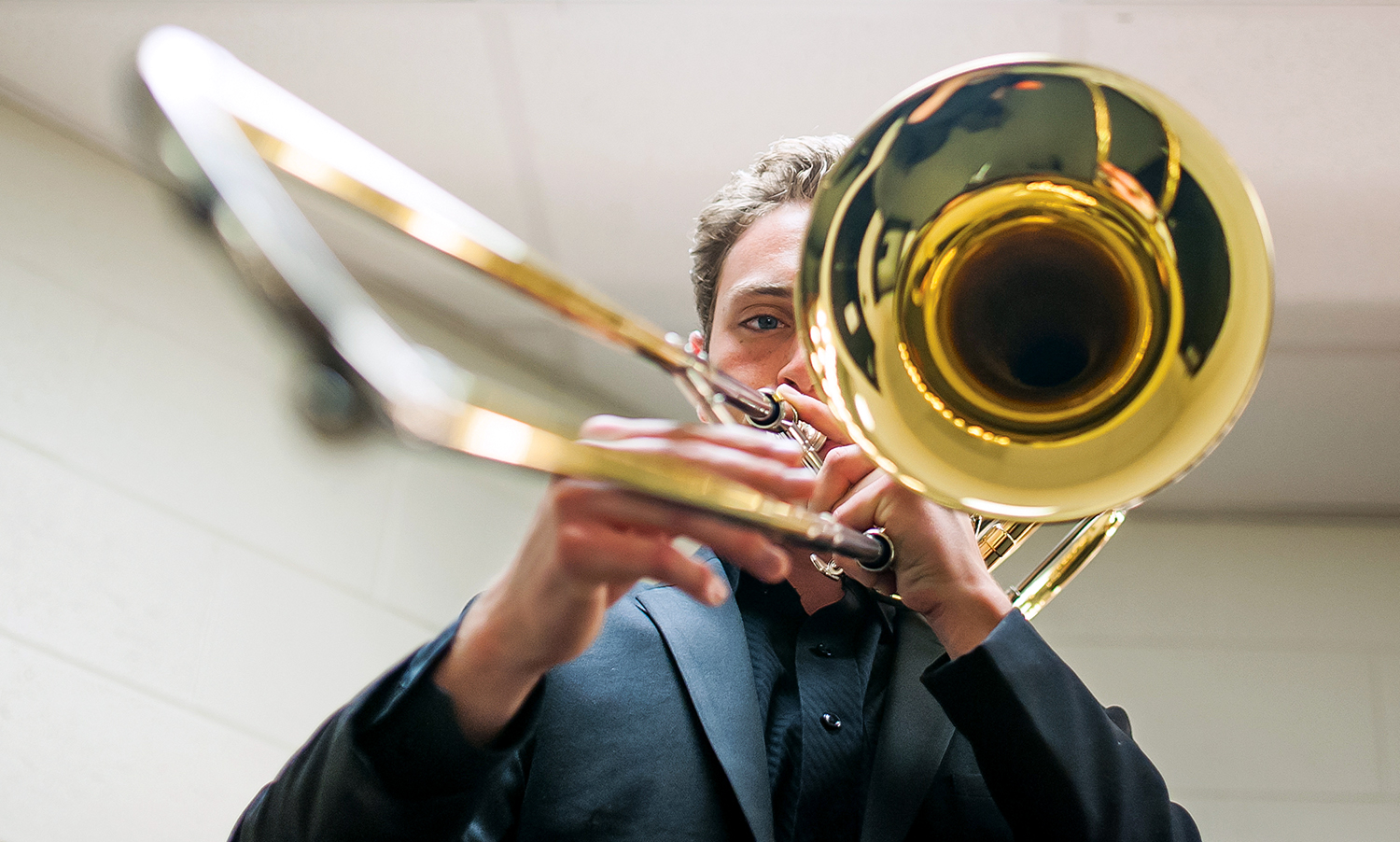
(Photo by Shane Snider)
The last flag falls, and it’s back to the garage, time for lunch and VIR’s tradition of letting the railbirds take their street cars on the twisting, hilly 3.27 miles of asphalt — no monkey business, they’re warned. Soon we are back in the Cadillac, only six of us this time. Peter and Kelly Albano stay back. Ben’s mother will not ride with him on a track, and we are seconds away from finding out why.
The car he’s racing today weighs 1,600 pounds. The Escalade goes 7,500, and the protocols for maximum speed entering the corner, braking, steering, throttling again, it seems, are alarmingly the same for both.
After one set of ess-curves, Albano says he really wasn’t going over 40. Forty is a relative term in the mammoth SUV on a track built for sports cars whose center of gravity is about 6 inches off the ground. The view out the windshield looks like a well-executed movie chase from the car-mounted camera. Passengers have found something to hold on to, praying the rubber is doing the same with the pavement.
When we settle onto pit road after two laps, one of those riding in the way back is not sure he would do this again.
Take a ride around Virginia International Raceway with Ben Albano ’18 during an October 2017 competition.
The October weekend ends a little prematurely for Albano, but it was memorable. On Friday, he drove up from Chapel Hill, got in a race car for the first time in a year and was clocked under the track record for his class (unofficial — it occurred in a practice session). He got home in time to find his seat in the trombone section in Memorial Hall for a Shostakovich symphony with the UNC Symphony Orchestra. Saturday morning, he was back across the border in time to qualify the car. He took off his uniform after his shift in the race, then put it back on for pictures with the trophy after he and his teammate won their class.
It was still early afternoon when, standing in the garage with three friends from school, he was asked if he’d be racing again on Sunday. He had a ride; not as big a race, but seat time still. He looked down at the ground, then back up. “I have to memorize a monologue for a class in acting for the camera, and a test to study for,” he explained sheepishly.
Like two drivers aiming for a spot on the track that only one can have, curricular and extracurricular had banged into each other again.
If there’s one thing Albano has mastered, it’s commitment.
Touching souls
The emotional intensity of Giuseppe Verdi’s Requiem is multiplied in Defiant Requiem: Verdi at Terezin, in which the backdrop to the music is the story of the Jewish concentration camp prisoners who defied countless odds to perform it — 16 times. In the words of the musician who taught the choir, “We will sing to the Nazis what we cannot say to them.”
When the Defiant Requiem Foundation brought the documentary to Chapel Hill in April last year, replete with video, narration and Broadway production values, it enlisted the UNC Symphony Orchestra, the Carolina Choir, the Chamber Singers and the men’s and women’s glee clubs.
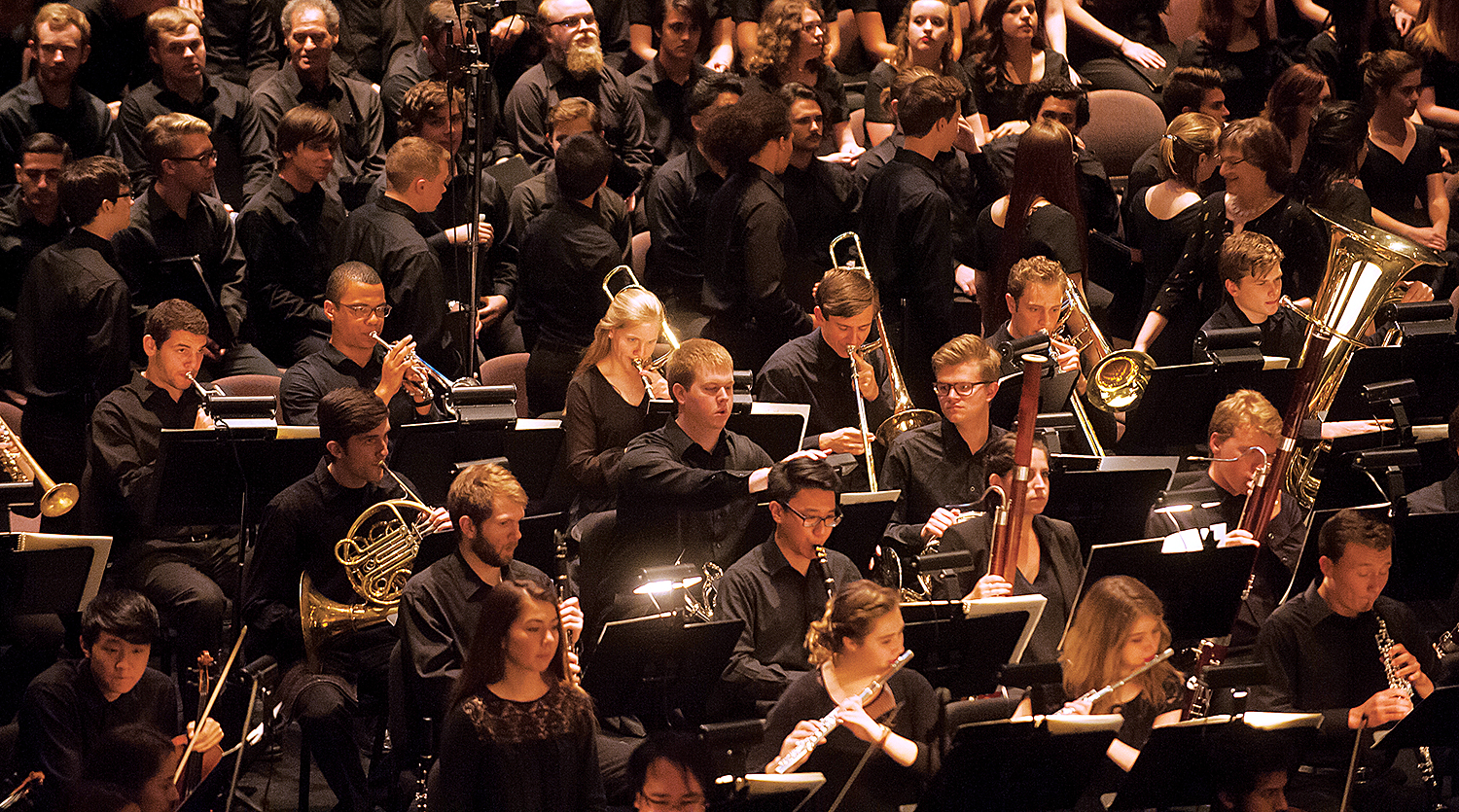
Albano, far right among the trombones, warms up before the April 2017 performance of Defiant Requiem. Besides the UNC Symphony Orchestra, multiple student choral ensembles were called on for the dramatic, large-scale work, and Memorial Hall was packed. (Photo by Shane Snider)
Albano switched from tenor trombone to bass — new for him — because that’s what the piece called for. It started to hit him in rehearsal: “I knew it would be definitely a hallmark of my college career, but I had no idea how powerful it was. It really was an extraordinary experience. It’s a message everybody should be exposed to.”
He seemed to delight in detail that quickly goes over a layperson’s head, just as he does when describing the litany of things that happen to a car when its weight shifts in a corner. “That conductor loves to hold the cadence. That last section of the piece is taken out of the tempo, slowed down for effect, and that’s difficult for brass players. At the end, I probably played the loudest note I ever played. Chills and goosebumps. I don’t know how to describe it. We play the two notes at the end with the train whistle, and the clarinet holds that note.”
Ben Albano says that performing Defiant Requiem: Verdi at Terezin was, in a way, the way you feel after a race — “pure bliss, to just utter depression.”
The train that brought the Jews to Terezin. There is no applause. The orchestra and choir file out row by row, silent and somber, like the captives in the video.
Ben Albano says that in a way, it’s the way you feel after a race — “pure bliss, to just utter depression.” He was supposed to be in Alabama this weekend for the first race of the Mazda MX-5 Cup season. As long as he’s not, he’ll play in a recital Saturday afternoon, then with Charanga Carolina, a Latin dance band, that night. He will have played three different types of trombones.
On Thursday, he says, “we reach out and touch people’s souls. On Saturday, we make people dance.”
A car guy — at 13
He can’t remember a time when he wasn’t looking at every car that passed by the house. When he was 5 or 6, he’d go out in the driveway, sit in the passenger seat and try to name each one that drove by. When he was 7, the family moved to London for his dad’s business. He started watching Formula 1 racing on TV. The great Michael Schumacher was at the midpoint of five straight championships.
“I was just enamored by him and the whole grandeur of everything,” Albano remembered. He not only watched. He did some go-kart driving in England.
On his eighth birthday, he was back in the States, now competition-legal in karting in his neck of Connecticut. He and his dad started going to the indoor track 20 minutes from home. Karting is the way a lot of professional drivers start, and a lot of child drivers get pushed; with Albano, he says, “my dad not knowing anything about racing, it was just really my interest.” But he got familiar with winning. He won championships at every successive level
of karting.
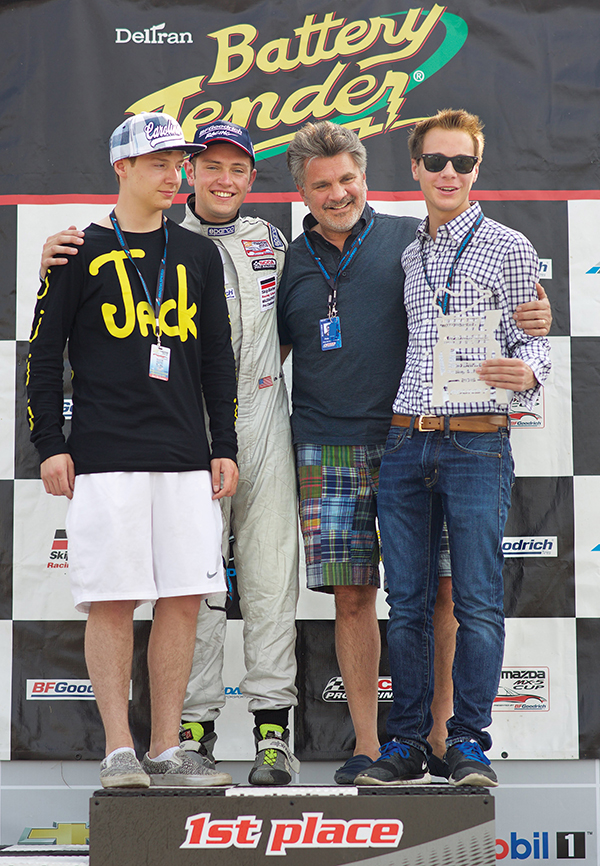
Albano with his father and brothers Austin and Addison on the podium after a race in Canada. His siblings, including sister Brittany, watch him race on their phones via in-car cameras when they can’t be there. (Photo by Leland Graham)
His dad raced against him some. Once they were in California, and Peter saw the blue flag, which means move over — you’re holding up the guy behind you. He assumed it was for the kart in front of him. Afterward, Ben asked him, “Why didn’t you move over?”
“I said, God, that’s it. I’m done,” Peter said. “I hung up my helmet.
“Once he went three hours in a go-kart without a bathroom break. He set the track record. He never looked back.”
And he got noticed.
The Albanos hired Lee Carpentier, a driver and personal trainer, to work with Ben when he was 11. Carpentier remembers watching Ben hold his own at a major event in Florida for advanced drivers from all over the world — some of whom had been racing since they were 5. The teacher was connected with the Skip Barber Racing School, then one of the premier developmental sports car series, and he recommended Albano make the leap.
“Ben was always right away very quick,” Carpentier said. “When he sets his mind to something, he pretty much does not give up until he’s figured it out.”
The Mazda is a race-tricked Miata. These cars are owned and set up by people who teach high-performance driving and put on events at the best road courses in the country. It is another of the stepping stones, and the few drivers who are good enough get to play, though they must bring some money to the table.
Thirteen was a little early; most of the kids who are serious about this don’t make this move until a couple years later. And this one found out almost immediately how elusive grandeur can be. What happened in a few seconds in November 2008 taught him how quickly things can go sour.
Albano had completed a three-day school for Skip Barber, and shortly he was back for a two-day advanced school.
“It was morning in the fall at Lime Rock [the Connecticut road course], there was some dew on the track at that corner. Also cold tires, it was the first lap of the day. I didn’t anticipate it, and I started to slide, and I turned left to try to balance the car back out, and I didn’t account for the change in weight.” His experience was of little use — karts have no suspension system — and into the outside barrier he went.
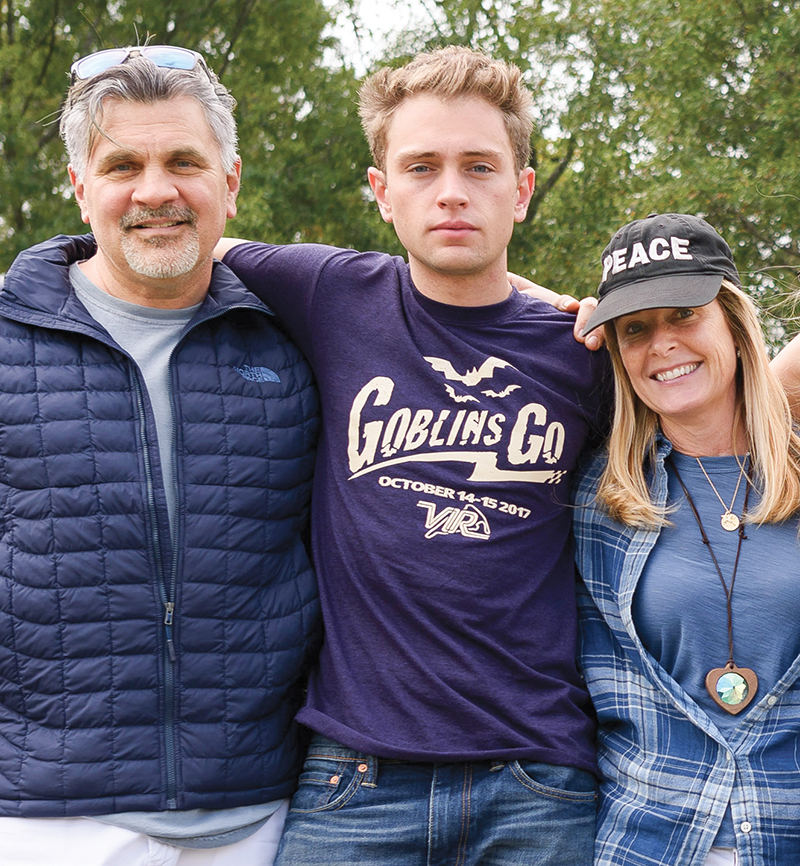
Albano’s parents Peter and Kelly have traveled extensively to the race tracks — Peter never has missed a race. There were anxious moments early in Albano’s career when he was racing before he was a licensed driver. (Photo by John Joyner)
“I got a call,” Kelly Albano said, “and I couldn’t see what had happened, and I was a mess. At that point, I felt I was being irresponsible.” What if, at age 13, he’d caused others to be hurt? “I said to Ben and my husband, ‘God forbid something happen before your legal driving age — how could I live with that?’ ”
He actually got back in the car that afternoon, but at football practice the next week he discovered he’d fractured a vertebra in the crash. He was liable for the damage to the car, too. It could have been worse — you tear up a car or two at this stage, and you can be shown the door for good. For Albano, it just set his ambitions back; he would return to karting for a while.
“I came home and I started crying. The first thing I thought about, and after every crash since, was, immediately, the money. What’s it gonna cost, how’s that gonna affect what I can do, because I was very aware of what everything was costing, and this is gonna be a big expense.”
Climbing the ladder
There is crying in racing. Your health and usually your money are on the line, and you’re often competing for a thousandth of a second, and it’s ecstatic, and it’s heartbreaking, for a driver of any age.
But at that point — before his first real race — Albano already had turned heads.
“I see a spectrum,” Carpentier said. “On one extreme is the jock, who has the ability to play the game. On the other end is an engineer who can put the pieces together — do the thinking. The greatest driver is gonna be somewhere in the middle. Ben does fit right in that middle.”
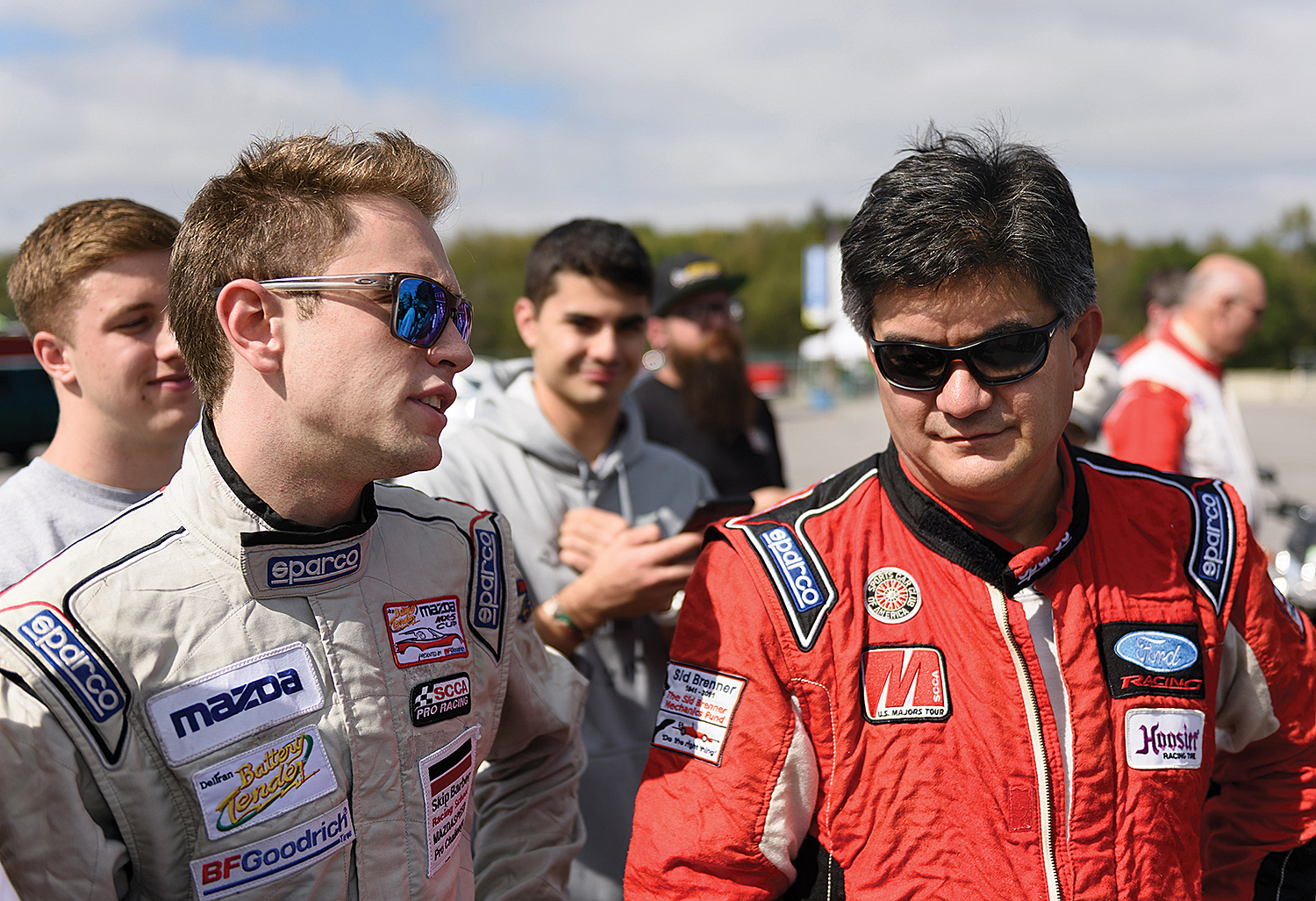
Albano conferrs with teammate Chris Brassard, the car’s owner, on the way to victory lane after a multi-class endurance race at VIR. (Photo by John Joyner)
“Natural ability is a special quality,” said Chris Brassard, who drove in the Barber organization for 14 years and now owns his own car, the car he and Albano co-drove at VIR. “Ben is of a different ilk. I saw all those qualities. He’s a good student — he studied it quietly — he’s on the shy side. He wins you over with his abilities. People who drive with Ben respect him.”
Albano met him when he ran into the back of Brassard’s car at Lime Rock. Brassard was impressed with the apology; the kid was impressed with his response.
“I’m going for the championship,” Brassard said. “He hit me. I just went up to him and said, ‘You’ve just got to keep your eyes up.’ He was just out of the gate.”
The learning curve is just one of the challenges. Albano’s parents financed the early years, but racers at the pre-professional level still pay a lot of the freight, and it gets expensive. Carpentier says that for about every level you step up in racing, the money doubles.
“My dad had a 20-year career on Wall Street that enabled the financial support of my racing dreams,” Albano said. “Fast forward to the financial crisis of 2008, however, and it became clear to me that my family sponsorship was finite, and I’d best hone my skill and luck in order to continue. This realization was especially frustrating, as I struggled to reconcile the choices being made between paying tuition and supporting my racing aspirations.
“It was especially curious to others in the racing community — all of whom have experienced the elusive pursuit of sponsorships — to see that money spent on college tuition was mutually exclusive with money spent on a car or with a team.
“I never thought of my college tuition as something I could trade for a ride in a race car, though, because tuition to my parents was an investment in my future, while spending money on racing was a more speculative bet, with a binary outcome, and the odds stacked against the participants. The reality was, when I asked my dad what the budget was for the 2015 racing season, he said, ‘Zero.’ ”
On the track, his gift was showing. Albano knew the way to the front of the field from the day of that first race in the Mazda in 2012. He was leading until the last lap, when “the nerves got the best of me,” and he spun the car.
He finished the season fourth in the standings — Rookie of the Year — with two wins and nine times in the top three. And he was climbing the ladder in the Barber development program: A successful year determines your placement for the next. He would spend two seasons in an amateur division before moving up to pro, and the second one was a breakout.
Albano avoids trouble in the first corner after starting 12th in his most recent race at VIR in April.
Albano won eight of the 10 races in 2013 and set five track records. He took the championship, and he laid out his goals for a Mazda publicist: “Professional sports car racing and, within 10 years, the 24 Hours of Le Mans.” There also was a mention of choosing a college.
“Throughout this entire endeavor, my parents were very adamant that racing doesn’t come second but school is always the primary focus, and I’m actually really grateful for that. … A lot of drivers that age are home-schooled — some of them don’t even really graduate high school, but those are the people who have the connections and the ability to not have to worry about anything else.
“That shaped my view of some of these drivers — they usually run out of money before they run out of talent. I didn’t really want to be that driver.”
The time commitment was significant — maybe 12 four-day weekends a year. Kelly Albano says they told him that if his school work dropped, “we can’t justify the racing, as talented as you are.”
He attended private school from the fourth to the ninth grades — and started focusing on music in the sixth — but switched to a public school that was less restrictive on his racing schedule. At first, he was turned off by the college admissions process. “All I wanted to do was race. I had a couple friends who were racing with me, and college wasn’t even on their radar. They just grew up in a different background, and it was hard for me to kind of reconcile their path with mine.”
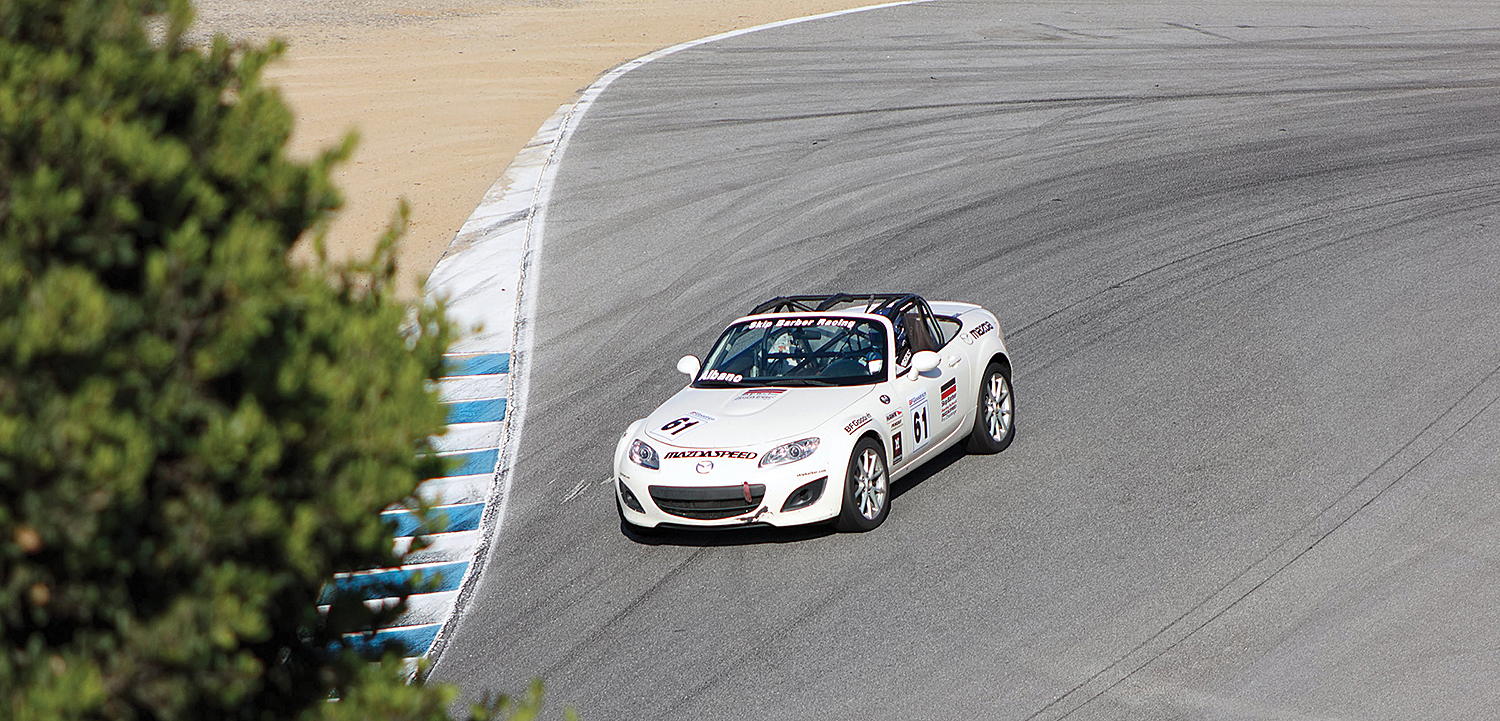
Albano in the Mazda in the infamous Corkscrew at Laguna Seca in California on the way to winning his first pro race — the same week he found out he was accepted at Carolina after being deferred. (Photo by Leland Graham)
Meanwhile he had earned his way into a professional series in the Barber hierarchy, where things continued to go well. He won four of 12 in 2014, including big-name tracks like Road America in Wisconsin and Laguna Seca in California. Along the way, he was earning the racing version of scholarships — money that could be redeemed only to pay to race at the next level. (Albano has won close to $200,000 of this restricted money in his career.)
And that fall, he matriculated to Chapel Hill. He’d received deferred admission, then was waitlisted. “Most deferreds will move on to another school,” said Mike Kris, an associate professor who teaches trombonists. Kris had been in touch since Albano’s junior year in high school.
“Before I take a student, I need to know there is a connection even before they start — we communicate. Ben reached back, with multiple email conversations. That’s why he got in — he invested in us. I knew as much about him coming in as a kid who’s been here a year.” Kris had others who played better, but Albano had the intangibles to be a successful music major.
“He made a very informed decision about Carolina. What’s not to like,” he added, “about a race car driver who’s a musician?”
As runner-up for the 2014 MazdaSpeed Pro title, Albano was poised to make a run at a championship that could put him on a much faster career elevator. It turned into a wild roller coaster ride.
“The first race weekend I drove into the back of someone, and it was a tiny tap, but it was in the braking zone where the car’s braking so hard, any small force to the back of the car would send the car flying.”
If you cause a collision, every position your victim loses costs you 10 points. So he lost 40 points the first weekend.
Then came Laguna Seca in May (he had rescheduled his final exams). As he entered a left-hand turn, somebody was sideways in front of him. The old adage that you go toward a spinning car because by the time you get there, it won’t be, did not play out. Then the pendulum swung: Albano won the next day, then swept both races at the next event, in Canada.
Albano crashes after a car spins in front of him at Laguna Seca in 2015
“So basically I clawed back from a 35-to-40-point deficit to be within one point of winning the championship going into the last race weekend [at Road Atlanta]. So I was going for broke.”
The winner got $100,000 toward his bills at the next level. It wasn’t Albano.
Branching out
On the last Sunday in January, he was on a plane back from Daytona Beach, doing school work. He’d done some spotting in a preliminary event to the annual 24-hour race; he worked the pits and the garage; he shook hands of old acquaintances and attended a dinner with people who know people who know people in racing.
Racing in college actually is easier than it was in high school, where class schedules are more rigid. In 2014 and 2015, Albano adjusted his schedules with professors much as varsity athletes do. He recalled the way fellow drivers in high school had been totally focused, with no plans for more school; he was struck with the irony of coming back to Chapel Hill after the intensity of a race weekend and having a hard time adjusting to life with students who weren’t sure what they wanted to do.
As the 2016 season approached, Albano realized he needed to put more time into school. Granted: If he’d gotten the ride he wanted, he would have raced. But at the moment he didn’t get the championship, he knew his time with the Barber organization was up, that he’d be among those beating the bushes for sponsorships that are few and far between.
“Definitely the hardest thing to grapple with every day, just to know that there wasn’t something to immediately look forward to. But I sort of structured my being so that every motivation in some way would benefit me in racing, whether it be exercise, or doing well in school, eating healthfully. I had to change my mindset about things. It helped me realize how much I want racing in my life. I think I had been becoming more jaded, I guess, and not really realizing how lucky I was to be able to race for so many consecutive years.”
He did some writing for The Daily Tar Heel. He got a summer internship with Motor Trend magazine and had stories published. He added writing to the career possibilities, with endorsements from a couple of his teachers.
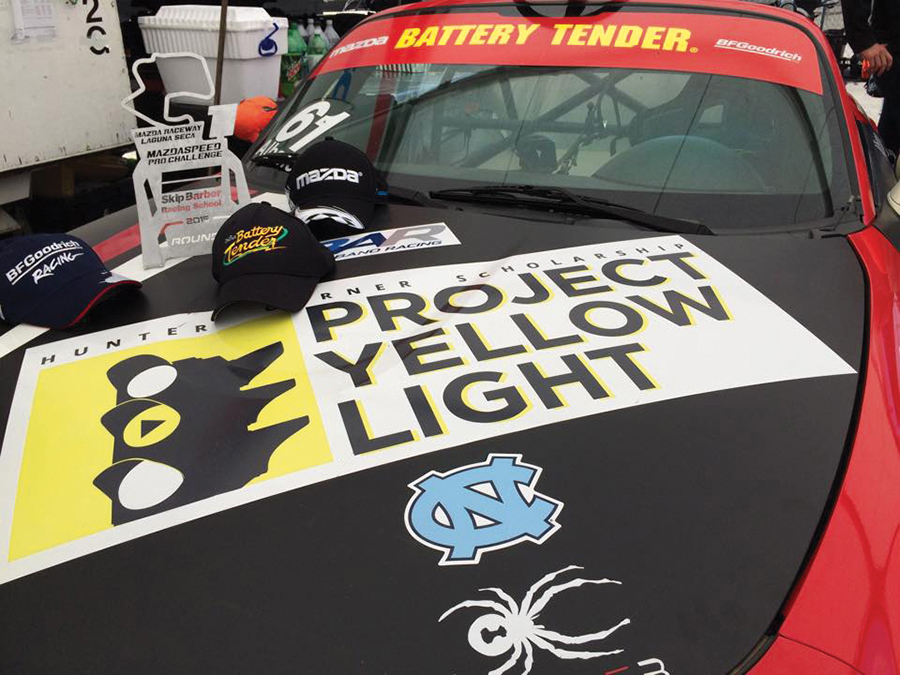
Albano has used the Mazda as a billboard for Project Yellow Light, a no-texting-while-driving initiative with which he and his brothers have been involved, and for his favorite school. (Photo by Leland Graham)
He kept a hand in a public service initiative. Project Yellow Light, focused on eliminating texting while driving, was founded by a couple who lost a child in a car accident. Albano and his brothers organized four fundraisers for the group starting when he was in high school. He looked into founding a chapter at Carolina but didn’t, mostly due to time constraints. And, he said, “the friends I have and people I’ve talked with about the idea all seemed to be dismissive of the idea that texting-handheld phone use in a car is a problem that needs to be addressed.”
Last summer, he had a chance to do some driving on the road course at Indianapolis Motor Speedway, but he already had committed to counseling at a two-week Red Cross camp that taught 5-year-olds the fundamentals of safety. He went back to Motor Trend.
The music would be enough for a lot of students. As Mike Kris said, music majors probably spend more one-on-one time with faculty than any other undergraduates.
Kris had a grant to send his musicians to London to perform with students of the renowned Kings College. Albano didn’t go because he was unfamiliar with the sackbut, a trombone from the Renaissance and Baroque eras. When the Kings students returned the favor and came here to perform, he got the chance to play with the much more experienced musicians.
“At one point, I got angry with him and some others because I didn’t think they had prepared well enough,” Kris said. Walking back from dinner downtown, he said to Albano, “ ‘Did I not say that would be the most important performance you would play in this year?’ I think he got it right then. He really rose to the occasion.”
He got started late on his music. He probably isn’t professional orchestra material. “Community orchestra, theater orchestra, yes, he could do it,” Kris said.
The dream is alive
Chris Brassard is cinched up tight, his helmet and head-and-neck protector in place, gloves on. He raises his visor, points to his car circling Virginia International and says, “He is really good.”
At the end of the first 45-minute shift, Albano comes down pit road. It’s a mandatory five-minute stop for the driver change, and he has time for hugs — Brassard, two crew members, and Mom is fourth in line — before he helps his teammate with the straps and the mirrors.
“Felt real good,” he says. “Nothing to do in a long race but stay smooth and steady. You can get greedy real quickly.” Rusty? “Not at all. Came right back.”
He’d been comfortable taking himself out of the driver’s seat in 2016. Last year, that turned to frustration.
Choosing the Verdi Requiem over the season-opening race, while it probably ended his championship hopes, did not shut him out of the series. What took care of that was a $400,000 price tag at a higher level of Mazda’s program — for which he could not corral a sponsor. The lesson learned: Be a better salesman, a better talker.
“Used to be the teams would find all the money,” Lee Carpentier said. “Now you have to bring it with you. For a teenager, there’s no business model for that. That’s the point in his career he is now.”
For the summer, Albano heard “no” from a potential $350,000 sponsor to drive a Lamborghini in another series.
One August day, he dropped the skateboard he uses to get around campus and sat down on a step near Hill Hall. He looked like he was about out of gas and pit road was closed. The October event at VIR was going to be his only race of the year.
There was another opportunity in California that same weekend — where winning could earn him some money — but there was the concert commitment.
He talked of some of his peers who are making it. They’ve gotten hold of money he couldn’t, and he doesn’t begrudge them that, but they’re also skipping college. Even as his parents guided him to school, they did not think he could succeed as a driver without unbroken devotion.
He’s taken a sports marketing course. There are real possibilities on the business end of racing. That Saturday at VIR, he focused on the car and spotting for his teammate, but he was mindful of what goes into the cars before they get to the track, how they’re maintained, financed and publicized, and he wondered how he could fit into that. (He’s also taught younger drivers at the development school.)
He speaks of the need to “craft a narrative” for his future. “In my heart, I don’t want to be saying that” — meaning, not being able to race.
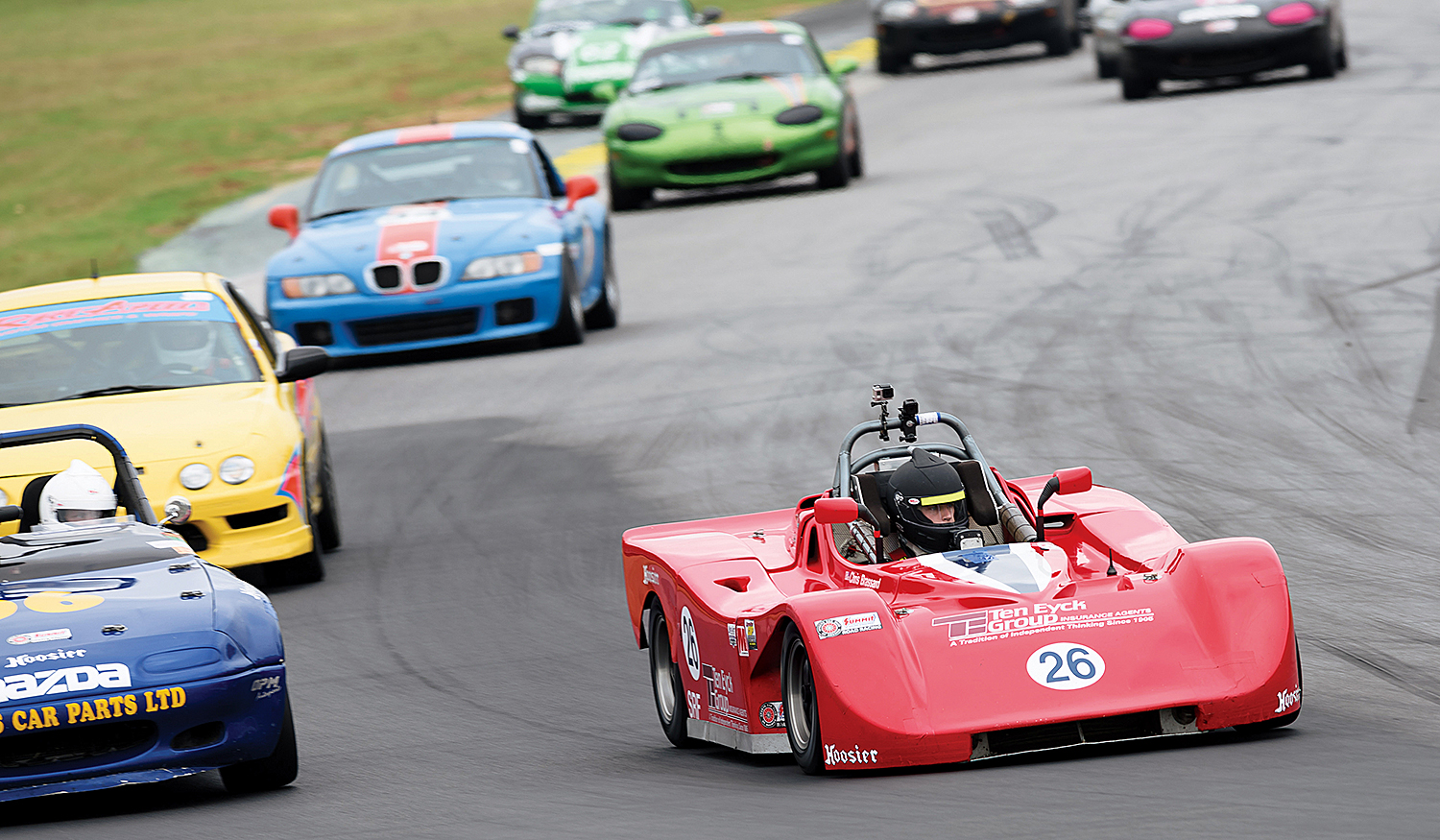
Albano (26) drives a Spec Racer Ford in the multi-class endurance race at VIR. (Photo by John Joyner)
“That’s the goal, that’s the dream. Of course, I wouldn’t be here if I had some sort of doubt or wasn’t completely sold on the fact that I will be a professional driver starting in the next two to three years. In my mind, it’s definitely possible, it’s just not the most realistic thing to expect. Racing full time requires complete dedication in every way and being at the right place at the right time, meeting the right people, shaking the right hand — someone watching you randomly turns on the TV and sees you make a pass.”
Learning how to push that machinery to its limit, to react to you-don’t-know-what around each blind corner, firing yourself up and talking yourself down eight times a lap, and outsmarting and out-reacting the others who’ve all done the same things — that gets in your blood and stays.
“Racing,” he said, “will find me at some point in my life.”
When Albano walks into Kenan Stadium in May, he’ll have had quite a bit more adventure than most of the people around him. But like so many of them, his future will be an unfinished canvas.
His mom is predictably optimistic, but she also has a sound point: That 25 percent, the driving part, is undiminished. “At any point in time, when he’s on the track, he’s got it.”
In April, the phone rang finally. Brassard and another driver, Steve Nelson, wanted to sponsor Albano at VIR in a national race for a more powerful version of the same type car he drove back in October. He tested on Thursday and Friday. In Saturday’s race, a car overtaking him appeared to use up too much track, and Albano went for a long ride in the grass.
On Sunday, he finished sixth among 51 drivers, and most of the other high finishers had years more experience in these cars. Brassard and Long finished behind him. And as Albano was leaving the track, they told him they’d arranged the sponsorship as a graduation present.
Somebody else was watching, too. Soon he was booking a flight for Watkins Glen, N.Y., to fill in behind the wheel of a Saab — which he’d never raced before — the following weekend. Suddenly things were looking up.
“I’m very grateful for the opportunity. Overall it feels great.” After missing two days of school each of the previous two weeks, he said: “I’ll only miss Friday. At the end of the day, I need to go to class.”
David E. Brown ’75 is senior associate editor of the Review.
Thanks for reading the Carolina Alumni Review
Carolina Alumni members, sign in to continue reading.
Not yet a member? Become one today.
